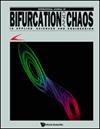Multiscale Effects of Predator–Prey Systems with Holling-III Functional Response
IF 1.9
4区 数学
Q2 MATHEMATICS, INTERDISCIPLINARY APPLICATIONS
引用次数: 0
Abstract
In this paper, we proposed a Holling-III predator–prey model considering the perturbation of slow-varying, carrying capacity parameters. The study aims to address how the slow changes in carrying capacity influence the dynamics of the model. Based on the bifurcation theory and the slow–fast analysis method, the existence and the equilibrium of the autonomous system are explored, and then, the critical condition of Hopf bifurcation and transcritical bifurcation is established for the autonomous system. The slow–fast coupled nonautonomous system has quasiperiodic oscillations, single Hopf bursting oscillations, and transcritical–Hopf bursting oscillations within a certain range of perturbation amplitude variation if the carrying capacity perturbation amplitude crosses some critical values, such that the predator–prey management is challenging for the extinction of predator populations under the critical value. The motion pattern of the nonautonomous system is closely related to the transcritical bifurcation, Hopf bifurcation and attractor type of the autonomous system. Finally, the effects of changes in parameters related to predator aggressiveness on system behavior are investigated. These results show how crucial the predator–prey control is for varying carrying capacities.具有霍林-III 功能响应的捕食者-猎物系统的多尺度效应
在本文中,我们提出了一个霍林-III捕食者-猎物模型,该模型考虑了缓慢变化的承载力参数的扰动。该研究旨在探讨承载力的缓慢变化如何影响模型的动力学。基于分岔理论和慢-快分析方法,探讨了自主系统的存在性和平衡性,进而建立了自主系统的霍普夫分岔和跨临界分岔临界条件。慢-快耦合非自主系统在一定扰动振幅变化范围内存在准周期振荡、单霍普夫猝发振荡和跨临界-霍普夫猝发振荡,如果承载力扰动振幅越过某些临界值,则捕食者-猎物管理面临临界值下捕食者种群灭绝的挑战。非自主系统的运动模式与自主系统的跨临界分岔、霍普夫分岔和吸引子类型密切相关。最后,研究了捕食者攻击性相关参数的变化对系统行为的影响。这些结果表明,捕食者-猎物控制对于不同的承载能力是多么重要。
本文章由计算机程序翻译,如有差异,请以英文原文为准。
求助全文
约1分钟内获得全文
求助全文
来源期刊
CiteScore
4.10
自引率
13.60%
发文量
237
审稿时长
2-4 weeks
期刊介绍:
The International Journal of Bifurcation and Chaos is widely regarded as a leading journal in the exciting fields of chaos theory and nonlinear science. Represented by an international editorial board comprising top researchers from a wide variety of disciplines, it is setting high standards in scientific and production quality. The journal has been reputedly acclaimed by the scientific community around the world, and has featured many important papers by leading researchers from various areas of applied sciences and engineering.
The discipline of chaos theory has created a universal paradigm, a scientific parlance, and a mathematical tool for grappling with complex dynamical phenomena. In every field of applied sciences (astronomy, atmospheric sciences, biology, chemistry, economics, geophysics, life and medical sciences, physics, social sciences, ecology, etc.) and engineering (aerospace, chemical, electronic, civil, computer, information, mechanical, software, telecommunication, etc.), the local and global manifestations of chaos and bifurcation have burst forth in an unprecedented universality, linking scientists heretofore unfamiliar with one another''s fields, and offering an opportunity to reshape our grasp of reality.

 求助内容:
求助内容: 应助结果提醒方式:
应助结果提醒方式:


